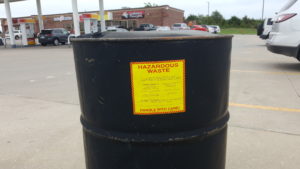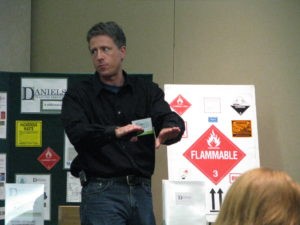A large quantity generator of hazardous waste (LQG) is subject to the RCRA regulations of the U.S. Environmental Protection Agency (USEPA) for the cradle-to-grave management of its waste. If the LQG will cease the accumulation of hazardous waste at a particular accumulation unit within its facility – even temporarily – then it is necessary to comply with the closure regulations of 40 CFR 262.17(a)(8). The purpose of this article is to explain the regulatory responsibility of a large quantity generator of hazardous waste for the closure of a hazardous waste accumulation unit (specifically, a central accumulation area for containers of hazardous waste) under new regulations codified by the Generator Improvements Rule.
Before we begin…
Regulations already in affect prior to May 30, 2017 required an LQG to take specific actions when closing certain hazardous waste accumulation units (tanks, drip pads, and containment buildings but not hazardous waste in containers) at its facility. Those regulations – originally found at §262.34(a)(1)(iv)(B) and now at §262.17(a)(8) – were clarified and strengthened as part of the Generator Improvements Rule. The most significant change was the addition of hazardous waste containers in a central accumulation area (CAA) to the existing closure requirements for tanks, drip pads, and containment buildings.
The Generator Improvements Rule has not – as of this writing – been adopted in all states. This particular requirement of the rule must eventually be adopted by all states since it is more strict than existing regulations. However, states have until July 1 of 2019 to adopt these more strict regulations. Read: What is the status of the Generator Improvements Rule in my state?
Scope:
The requirements of §262.17(a)(8) are applicable to…
- A LQG. Neither a small quantity generator (SQG) nor very small quantity generator (VSQG) of hazardous waste are subject to these regulations. The minimal closure regulations applicable to a SQG that accumulates hazardous waste in a tank are found at §262.16(b)(3)(vi). There are no closure requirements for a VSQG. A treatment, storage, and disposal facility (TSDF) has its own closure regulations found in parts 264/265 of Title 40.
Not sure of your hazardous waste generator status? |
- The accumulation of hazardous waste. Wastes that are non-hazardous, hazardous but excluded or exempt by regulation, managed by the generator under an option other than hazardous waste (e.g. universal waste, used oil), or those regulated as a hazardous waste by state regulations but not Federal are not subject to these USEPA closure regulations
- The accumulation of hazardous waste in a central accumulation area (CAA), not a satellite accumulation area (SAA). §262.17(a)(8)(v) states this clearly.
- The closure of an accumulation unit at a facility and/or the closure of the facility. Note: this article will address solely the requirements for closure of an accumulation unit. If interested in the requirements for closure of a facility, read: Large Quantity Generator of Hazardous Waste Facility Closure. The closure of an accumulation unit means hazardous waste accumulation will cease – even temporarily – at that precise location though it may continue
- elsewhere within the facility. To further clarify: moving a 55-gallon hazardous waste drum from one area of the facility to another is considered to be closure of an accumulation unit.
- The accumulation of hazardous waste in any of the four (4) hazardous waste accumulation units: containers, tanks, containment buildings, and drip pads. Read more about the four hazardous waste accumulation units. Note: this article will focus solely on the closure requirement for hazardous waste accumulated in containers.
Contact me with any questions you may have about the generation, identification, management, and disposal of hazardous waste Daniels Training Services, Inc. 815.821.1550 |
The Purpose:
USEPA’s purpose with these new regulations (part of the Generator Improvements Rule) is to ensure LQGs accumulating hazardous waste in containers meet the same closure requirements as LQGs accumulating hazardous waste in tanks, drip pads, and containment buildings. USEPA has determined that a significant number of site clean-up operations undertaken by Superfund have been caused by improper closure of hazardous waste accumulation units that are containers of hazardous waste in a CAA.
80 FR 57955 USEPA provided a list of Superfund clean-ups caused by LQGs who abandoned sites without proper closure of hazardous waste container CAAs.
Requirements for Closure of a Hazardous Waste Accumulation Unit (Container(s) in CAA):

If a large quantity generator of hazardous waste intends to permanently or temporarily halt the accumulation of hazardous in containers at a central accumulation area at its facility it must perform one of the following.
- Place a notice in the facility’s operating record within 30 days after closure of the hazardous waste accumulation unit. Notice must identify the location of the unit within the facility. If the waste accumulation unit is subsequently reopened, the generator may remove the notice from the operating record.
Or…
2. Submit the notifications and meet the closure performance standards in the same manner as for closure of a facility (see below).
Notification:
- LQG must notify EPA – or its state – no later than 30 days prior to closing the hazardous waste accumulation unit. The notification must be made using the Federal 8700-12 Form unless your state has its own form for this purpose.
- LQG must also notify EPA – or its state – within 90 days after closing the hazardous waste accumulation unit. The notification must be made using the Federal 8700-12 Form unless your state has its own form for this purpose. This notification must indicate whether the facility has complied with the closure performance standards (i.e. “clean close”, more on that later) or is unable to meet the closure performance standards and therefore must close under the regulations applicable to a landfill (more on that later too).
- LQG may be granted additional time to clean close if it does the following:
- Notify EPA – or state- within 75 days of the submittal of the initial notification.
- Notification must be made on EPA 8700-12 Form or the state equivalent.
- Notification must include an explanation as to why the additional time is required.
Performance Standards for Clean Close:
Note: the information below is a summarized version of the regulations at §262.17(a)(8)(iii). I attempted to capture the intent of the performance standard while avoiding the excessive descriptions found in the regulations. Please read the regulations for a full description of the closure performance standards.
- LQG must close each hazardous waste accumulation area at the facility to prevent the future release of any hazardous waste to the environment.
- LQG must also remove or decontaminate all contaminated equipment, structures, soil, and any remaining hazardous waste.
- Manage any hazardous waste generated during closure according to the regulations applicable to an LQG.
An LQG performing a clean close is not required to have a closure plan or financial assurance. (RO 14321)
Like this article? Subscribe to my Monthly Newsletter No marketing emails! |

If Unable to Perform Clean Close:
If the LQG is unable to meet the closure performance standards (i.e. clean close) and can demonstrate that the contaminated soils and wastes cannot be practicably removed or decontaminated from any accumulation unit(s) the LQG must close the waste accumulation unit(s) and perform post-closure care per the regulations applicable to a landfill at §265.310 and subparts G and H of part 265. Requirements for closure as a landfill include, but are not limited to, the following:
- Installing groundwater monitoring wells upgradient and downgradient from the container area.
- Installing monitoring wells for 30 years or longer during a post-closure care groundwater monitoring program.
If you like this article, please share it using any of the social media platforms identified at the bottom of this article. You’ll look real smart recommending my articles! |
Conclusion:
In this order:
- Comply with the regulation applicable to a large quantity generator of hazardous waste at 40 CFR 262.17, including initial and annual renewal training for your Hazardous Waste Personnel.
- If necessary to close a hazardous waste accumulation unit – even temporarily – take option #1!
- If closure of the facility ever becomes necessary, comply with the regulations of §262.17(a)(8)(ii-iii). Read: Facility Closure for a Large Quantity Generator of Hazardous Waste
- Contact me if you have any questions about the USEPA (and state) regulations for the management of waste.

